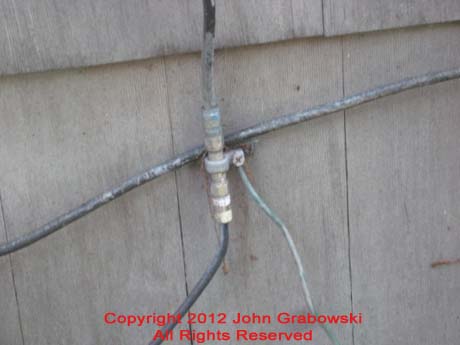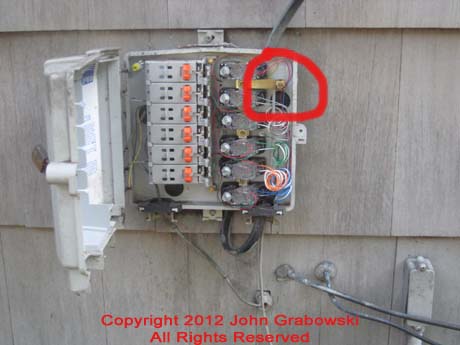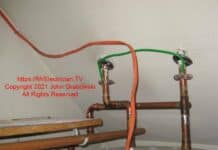Dear Mr. Electrician: What can I do about grounding TV and telephone in my house? I want to have good lightning protection. My neighbor was blown out of her chair when lightning hit her TV. How can I prevent that from happening to me?
Answer: Even with a fantastic grounding TV and Telephone, there is no 100% foolproof method of lightning protection or stopping a lightning strike from doing damage.
NOTE: Some text links below go to applicable products on Amazon. As an Amazon Associate, I earn from qualifying purchases. Using my links helps to keep this website FREE.
However, several things can be done to prevent or reduce lightning damage. Everything electrical needs to be properly grounded and bonded in such a manner as to provide a good direct path for lightning to flow to the earth.
An excellent book on the subject of lightning protection installations is NFPA 780.
The photos below depict an actual job of mine correcting the grounding for a 1940s single-family detached house.
Article 250 in the National Electrical Code concerns grounding and bonding. Some relevant sections are 250.8, 250.52, 250.90, 250.94, and 250.104. Also, read article 800.100 on grounding communication circuits and 820.100, which concerns the grounding of cable TV systems.
LIGHTNING PROTECTION FOR POWER, TV, TELEPHONE

The above photo depicts how I found the grounding of the TV and telephone lines. It turns out this pipe was not connected to anything. It was in the ground only a few inches and contained a piece of cut electrical cable, the remains of which protruded from the pipe. This would not be adequate protection if lightning were to strike.
The telephone demarcation point and the cable TV demarcation terminal both need to be bonded to the grounding electrode conductor for the main electrical service. Newer electrical installations have an intersystem bonding termination for connecting the grounding conductor from the telephone and cable TV.
In older houses, the TV and telephone grounding conductors are sometimes connected to an existing ground rod or water pipe, have their own separate ground rod, or are connected to the grounding electrode conductor.
CLICK HERE to See Surge Protection Devices on Amazon

Above was the current cable TV ground connection. I installed a new #10 copper wire and clamped it to the grounding electrode conductor connected to the water pipe inside the house.
The copper wire for grounding the TV and telephone must be no smaller than #10 AWG. #8 wire would probably be too big for most demarcation terminals.

For adequate grounding of TV and telephone, all interior metal piping must be bonded using water pipe ground clamps with wire jumpers around water meters, water heaters, water softeners, water filters, and other devices whose removal would interrupt ground continuity.
If a section of metal pipe is replaced with plastic pipe, a bonding jumper must be installed to maintain grounding continuity.
The hot and cold metal water pipes must have a jumper between them. This is usually done at the water heater. Although the code requires gas pipes to be bonded, some local areas do not want that. Check with your local building department about bonding the gas pipe.
You can see a water heater bonding on page 2.

The arrow in the photo above indicates the existing grounding terminal on the original telephone demarcation point. It was still active, now fed from the new outside telephone demarcation box. The current ground wire was attached to a water pipe at a sink in the back of the basement instead of the water main near the water meter.
The grounding electrode conductor from the main electrical panel is connected to the metal pipe water main before the water meter. If only a plastic main water pipe existed, then one or more ground rods would be required for lightning protection.



The neutral conductor is bonded to the grounding electrode conductor in the first main electrical disconnect after the electric meter. This is called the main bonding jumper. After that, the neutral and the ground wires are always kept separate.

The photo above depicts the old water main and grounding electrode conductor connected to the copper pipe. A new grounding conductor was installed when the new copper piped water service main was installed.
You can see below what the new water pipe ground connection looked like after several years.

As you can see in the above photo, the existing water pipe ground clamp is quite corroded. This is not an unusual sight. The ground clamps tend to corrode after years of being in a damp basement without maintenance.
The grounding electrode conductor connection at the water pipe must be tight and corrosion-free. See the replacement for the rusted clamp in the above photo on page 2.










